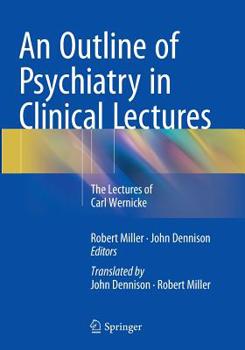An Outline of Psychiatry in Clinical Lectures: The Lectures of Carl Wernicke
TABLE OF CONTENTS
Foreword
Editor's Foreword
Dedication for this Translation
Preface to this Translation
PART 1: Psycho-physiological Introduction
Introduction to this Translation
Lecture 1
Mental illnesses are brain diseases; nevertheless, they differ from them in practice. Projection system and central fields of projection. Association organ. Brain disorders to be defined as: diseases of the projection system; mental illnesses as: propagated illnesses of the association organ. Difference between primary and secondary identification in the case of speech.
Lecture 2
To replace the Conceptualization Centre in the Speech schema by arbitrary, localized apperceptions. Registration and goal identification in the Speech schema. Generalization of the Speech schema. Types of movement: expressive, reactive, and initiative movements. Disturbance of Secondary Identification is induced by psychosensory, psychomotor, or intrapsychic means.
Lecture 3
Nature of memory images. Retinal after-images and remembered visual images. The hypothesis of special sense cells and memory cells is insufficient as an explanation. Local signs in the retina. Visual representations.
Lecture 4
The concrete concept of an 'association of memory images'. Awareness of the outside world. Number of concepts. Requirement of causality.
Lecture 5
The body is a part of the outside world. Awareness of physicality is a function of the central projection fields. Organ sensation and sensory content of sensations. Feeling tone of sensations. The large intestine represented in bodily-awareness.
Lecture 6
Concept of spontaneous movement. Distinction from reflex movement. Position sense and position representation. Sensations of nervous activation of muscle, and their memory images. Sense of motion and movement imagery both derive from organ sensations. Also, tactile sensations and touch representations from the hand's tactile organ are derived from organ sensations.
Lecture 7
Consciousness of personhood, or individuality. Is its localization accessible? The mystery of self-awareness.
Lecture 8
The activity of consciousness dependent on the content of consciousness. 'Preformed' organization of the connections of thought. Narrowness of consciousness. Level of consciousness. Attention and will. Ability to be attentive; Affect. Normal value of apperceptions.
PART 2: The Paranoid States
Lecture 9
Overview of clinical results. Mental disturbance. Mental illness. Paranoid states. Unrecovered mental patients. Patient demonstrations.
Lecture 10
Patient presentations (continued).
Lecture 11





